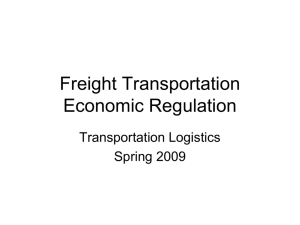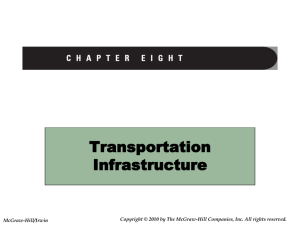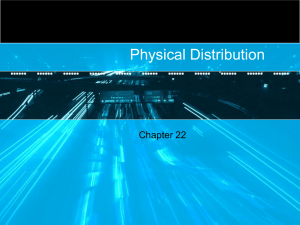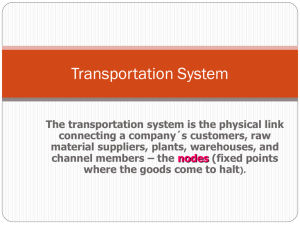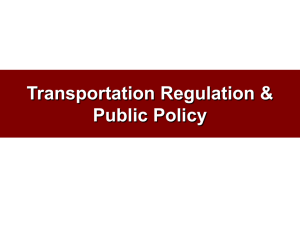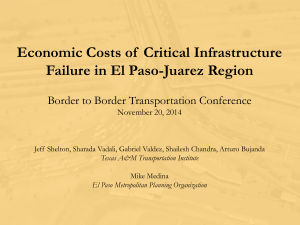Highway Transportation Outline
advertisement
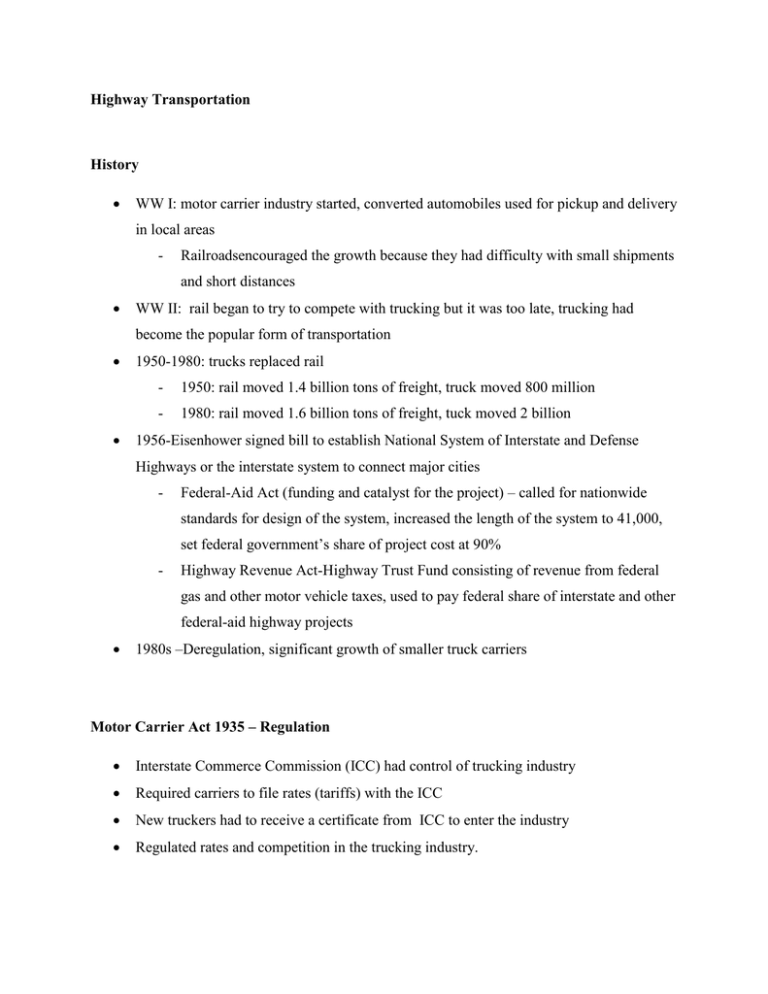
Highway Transportation History WW I: motor carrier industry started, converted automobiles used for pickup and delivery in local areas - Railroadsencouraged the growth because they had difficulty with small shipments and short distances WW II: rail began to try to compete with trucking but it was too late, trucking had become the popular form of transportation 1950-1980: trucks replaced rail - 1950: rail moved 1.4 billion tons of freight, truck moved 800 million - 1980: rail moved 1.6 billion tons of freight, tuck moved 2 billion 1956-Eisenhower signed bill to establish National System of Interstate and Defense Highways or the interstate system to connect major cities - Federal-Aid Act (funding and catalyst for the project) – called for nationwide standards for design of the system, increased the length of the system to 41,000, set federal government’s share of project cost at 90% - Highway Revenue Act-Highway Trust Fund consisting of revenue from federal gas and other motor vehicle taxes, used to pay federal share of interstate and other federal-aid highway projects 1980s –Deregulation, significant growth of smaller truck carriers Motor Carrier Act 1935 – Regulation Interstate Commerce Commission (ICC) had control of trucking industry Required carriers to file rates (tariffs) with the ICC New truckers had to receive a certificate from ICC to enter the industry Regulated rates and competition in the trucking industry. Motor Carrier Act 1980 – Deregulation This law partially deregulated the industry Easier entry into the industry = increase in the number of carriers Eliminated many restrictions on commodities Encouraged carriers to increase or decrease rates to increase competition Types of Carriers Private: service to industry or company that owns or lease vehicles, does not charge fee - Motor Carrier Act of 1980: eased entry requirements, private carriers could charge a fee for trucking services for a subsidiary (vehicle) 100% owned and act as an exempt for-hire carrier For-hire:provides a public service, charges a fee - Local: pickup and deliver freight within the city zone - Intercity:operate in between city zones. Often work with local carriers to pick up and deliver goods in the city zones. - Exempt: carriers exempt from economic regulations o Determined by type of commodity or nature of its operation o Laws of marketplace determine rates, the service provided, and the number of vehicles provided - Common: required to serve the general public on demand and at a reasonable rate - Contract: under contract to serve specific shippers - Truckload:volume meets the minimum weight required for a truckload shipment and truckload rate. Picks up and delivers the same truck load - Less-than-truckload:volume lower than minimum, consolidate smaller shipments into truckload quantities for line haul/intercity movement and must then again separate the loads into smaller quantities for delivery Low Startup Fees $5,000-10,000 to start Many small carriers or Class III, main reason for significant growth in the 1980s Class I and II have more invested because their companies are larger and require more trucks and terminals, entry into the industry is more limited than Class III Truckload vs Less-than-truckload: LTL require terminals to separate and consolidate shipments, therefore, their startup fee is higher and entry is more limited Commodities Almost 100% of sheep, lambs, cattle, and hogs to stockyards More than 50% of food products, manufactured products, consumer goods and industrial goods Less than 50% of tons moved of grains, primarily nonferrous metal products, motor vehicles and equipment, paper and allied products because these items usually require long distance hauls and have large volumes, rail and water is more common for these commodities Competition Rivalry between carriers Low entry fee, freedom to enter, and discounting of services have made it easy for individual trucks to compete with larger carriers Market oriented - Carriers are forced to meet demand and consumers needs - Smaller for-hire carriers are more capable of giving individual attention to customers whereas larger carriers are more limited in the attention they can give customers Competition between modes 30,000-60,000 pounds hauled less than 300 milestruck 90,000 pounds or more hauled more than 100 milesrail In between these ranges rail and truck compete Advantages Accessibility: access to any location/destination and provides a link between other modes of transportation and the final destination of goods Fast/speed: with trucks and the highway system, products can be delivered directly from the truck and without delay the delay of being unloaded/loaded like other forms of transportation experience (rail, air, water) No highway constraints: trucks can travel on any highway unlike rail and water that have to pay fees/rates to cross over and use other company’s facilities. Small capacity: consumer can have lower inventory levels, lower inventory costs, and more frequent services Minimum Shipping Weights by Mode: Truck 25,000-30,000 pounds Rail Car 40,000-60,000 pounds Barge hundreds of thousands of tons Smooth ride: less chance of damage to goods Consumer market oriented: very responsive to consumer needs Types of Vehicles Line-Haul: haul freight long distances between cities, truck trailer combo of 3 or more axles City Trucks:smaller than line-haul vehicles and are single units 20 to 25 ft long with cargo unit 15 to 20 ft long. There is a growing use of small trailer 20 to 28 ft to deliver freight to deliver freight in the city Special Vehicles: vehicles specifically designed to meet shippers needs, these can be subject to special regulations ( ex: number of lights on the vehicles, brakes used, tire specifications, allowable length and/or height) - Dry van-standard trailer or truck with all sides enclosed - Open top-trailer open for odd-sized freight - Flatbed-no top or sides and usually used to haul steel - Tank Trailer-liquids and petroleum products - Refrigerated vehicles-controlled temperature - High cube-higher than normal to increase cubic capacity - Special-unique design to carry a specific product Terminals Pick up and delivery- freight is collected from shippers and consolidated with loads going in same direction or same destination. Shipments are line-haul to destination then the load is then separated and then loaded onto city trucks for delivery. These terminals are also used to change shipments from one carrier to another carrier when needed. This might be necessary when a carrier does not have the authority to deliver a shipment to its final destination - Functions : sales, billing, claim handling, and some limited vehicle maintenance Break-Bulk-separation of combined shipments consolidated truckloads arrive from many pick up terminals. Freight is unloaded sorted by destination and reloaded for dispatch to destination usually centrally located and at juncture of highways. Relay-at these terminals one driver is substituted for another whoa has accumulated the maximum hours of service necessary under DOT. Driver Hour Regulations: -Drive maximum of 10 hours after 8 consecutive hours off duty -On duty maximum of 15 hours after 8 consecutive hours off duty -No driver can drive after 60 hours on duty in 7 consecutive days -No driver can drive after 70 hours on duty in 8 consecutive days Cost Structure Fixed-costs: account for 10-30% of total cost, fixed-cost are low because of the high amount of public investment in the highway system, low entry fee for small carriers, and carriers can easily adjust the number of vehicles available - Tractor trailer fixed costs:interest on vehicle, insurance, license, depreciation and interest on terminals, management, and overhead (utilities) Variable costs: account for 70-90% of total cost, includes fuel, wages, and maintenance - Fuel and labor account for majority - Labor: costs about 50% of the carriers revenue meaning about 50 cents out of every dollar earned in revenue goes to labor, intercity drivers are usually paid by mileage - Fuel: as fuel prices continue to rise, fuel cost will continue to be a major portion of the variable cost Operating Ratio: measure of operating efficiency 𝑜𝑝𝑒𝑟𝑎𝑡𝑖𝑛𝑔 𝑟𝑎𝑡𝑖𝑜 = 𝑜𝑝𝑒𝑟𝑎𝑡𝑖𝑛𝑔 𝑒𝑥𝑝𝑒𝑛𝑠𝑒𝑠 𝑥100 𝑜𝑝𝑒𝑟𝑎𝑡𝑖𝑛𝑔 𝑟𝑒𝑣𝑒𝑛𝑢𝑒𝑠 -the closer to 100, the higher the need to raise rates to generate more revenue -For example, 94 means 94 cents of every dollar goes to expenses -usually between 93 and 96 - ≥ 100 = no revenue Funding Construction, maintenance, and policing of highways paid by highway user’s taxes (truck and automobile drivers) Taxes - Federal Highway Trust Fund: from this federal government pays 90% of construction costs for the interstate system and 50% for all other federal-aid costs - State taxes:fuel tax (cents per gallon), vehicle registration fees, ton-mile taxes, special use permits Issues Safety: improved safety = profit, less expensive claims for lost/damaged goods, increase in insurance, accidents, fines - Drug testing-requirement for employment, part of a regular physical exam, for cause, and random selection Improve training programs for driving and other job related activities New technology: satellites are being used to pin point exact location throughout the movement from origin to destination. Drivers can be rerouted for poor weather and/or road conditions. With the movement of hazardous good, the movement can be monitored and carriers can have a quick reaction to accidents or spills. Federal Motor Carrier Safety Administration (FMCSA) Mission: “Prevent commercial motor vehicle-related fatalities and injuries” Established January 1, 2000 under the Motor Carrier Safety Improvement Act of 1999 Activities o Enforcement of safety regulations o Targeting high-risk carriers and commercial motor carriers o Improving safety information systems and technologies o Strengthening equipment and operating standards o Increasing safety awareness American Trucking Association (ATA) Established 1933 - American Highway Freight Association and Federation Trucking Associations of America came together to form ATA “The mission of the American Trucking Associations, Inc., is: to serve and represent the interests of the trucking industry with one united voice; to influence in a positive manner Federal and State governmental actions; to advance the trucking industry’s image, efficiency, competitiveness, and profitability; to provide educational programs and industry research; to promote safety and security on our nation’s highways and among our drivers; and to strive for a healthy business environment.“ Kentucky’s Highways Freight tonnage o 43% inbound o 73% outbound 47.2 vehicle miles of travel annually 78, 913 miles of public roads and streets 9 interstate Highways 73% within state, 28% from state, 38% to state (by weight) Highway Design Basics Things to consider when designing Functional Class Horizontal Alignments o Components o Terms o Equations o Superelevation Vertical Alignments o Components o Crest and Sage Curves o Terms o Equations Sight Distance o Stopping Sight Distance o Passing Sight Distance Design Criteria Sources Coyle, John Joseph, Edward J. Bardi, and Robert A. Novack. "Chapter Five:Motor Carriers." Transportation. 5th ed. St. Paul/Minneapolis: West Pub., 1994. 130-55. Print. "Federal Motor Carrier Safety Administration."Federal Motor Carrier Safety Administration.N.p., n.d. Web. 10 Aug. 2012. <http://www.fmcsa.dot.gov/>. "Federal Highway Administration." Home. N.p., n.d. Web. 14 July 2013. "Freight Modes in Kentucky." Kentucky Transportation Cabinet, Apr. 2011. Web. 26 Apr. 2012. <http://transportation.ky.gov/Planning/Documents/Freight%20Modes%20in%20Kentucky.pdf>. "Kentucky Transportation Cabinet - KYTC." Web. 26 Apr. 2012. <http://transportation.ky.gov/Pages/default.aspx>. "Interstate System -Design - FHWA."Interstate System -Design - FHWA. Federal Highway Administration, 14 Mar. 2012. Web. 09 May 2012. <http://www.fhwa.dot.gov/programadmin/interstate.cfm>. Lindeburg, Michael R. "Ch 79 Horizontal, Compound, Vertical, and Spiral Curves." Civil Engineering Reference Manual for the PE Exam. Belmont, CA: Professional Publications, 2008. N. pag. Print. Moore, Thomas G. "Trucking Deregulation." (n.d.): n. pag. Library of Economics and Liberty. Web. 12 Aug. 2012. <http://www.econlib.org/library/Enc1/TruckingDeregulation.html>. A Policy on Geometric Design of Highways and Streets, 2011. Washington, D.C.: American Association of State Highway and Transportation Officials, 2011. Print. "Trucking.org."Trucking.org. N.p., n.d. Web. 10 Aug. 2012. <http://www.trucking.org/pages/home.aspx>.


